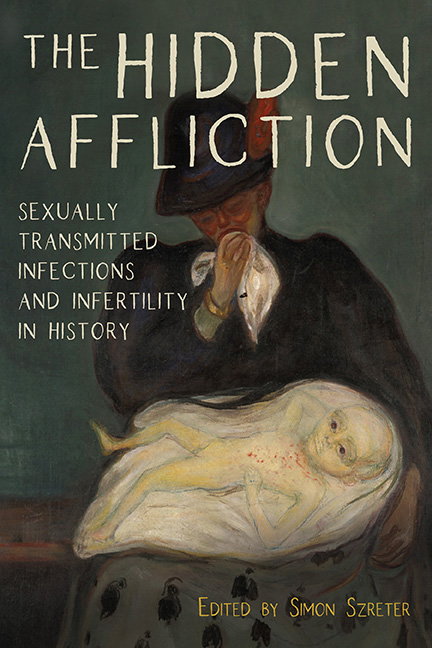Book contents
- Frontmatter
- Contents
- Acknowledgments
- Introduction
- Part One The Hidden Pitfalls in the Early Documentary Record
- Part Two The Biomedical Sciences and the History of the STI Microorganisms
- Part Three Population Decline in the Global South
- Part Four Infertility and the Specter of Venereal Diseases in Modern Europe
- 10 “The Archenemy of Fertility”: Gonorrhea and Infertility, Germany 1870–1935
- 11 Fecundity in a World of Scourges: Venereal Diseases, Criminal Abortion, and Acquired Infertility in France, circa 1880–1950
- 12 Revealing the Hidden Affliction: How Much Infertility Was Due to Venereal Disease in England and Wales on the Eve of the Great War?
- List of Contributors
- Index
10 - “The Archenemy of Fertility”: Gonorrhea and Infertility, Germany 1870–1935
from Part Four - Infertility and the Specter of Venereal Diseases in Modern Europe
Published online by Cambridge University Press: 25 March 2020
- Frontmatter
- Contents
- Acknowledgments
- Introduction
- Part One The Hidden Pitfalls in the Early Documentary Record
- Part Two The Biomedical Sciences and the History of the STI Microorganisms
- Part Three Population Decline in the Global South
- Part Four Infertility and the Specter of Venereal Diseases in Modern Europe
- 10 “The Archenemy of Fertility”: Gonorrhea and Infertility, Germany 1870–1935
- 11 Fecundity in a World of Scourges: Venereal Diseases, Criminal Abortion, and Acquired Infertility in France, circa 1880–1950
- 12 Revealing the Hidden Affliction: How Much Infertility Was Due to Venereal Disease in England and Wales on the Eve of the Great War?
- List of Contributors
- Index
Summary
In March 1929 Maria Meyer was discharged from the university hospital in Tübingen, where she had been treated for infertility. At thirty-four years of age, Meyer had been married for seven years to a shopkeeper and had never conceived. Years before she had undergone surgery at a hospital in Konstanz; now she had been treated with conventional therapies, including the application of light, heat, and water. For diagnostic and therapeutic purposes, an abrasion of her uterus had been performed. An insufflation of her tubes had shown that these were patent. Everything seemed to be okay. But, upon leaving the hospital, Meyer told the doctors that her parents tormented her. They believed that she would not conceive because her husband had infected her with gonorrhea. To counter such accusations, the doctors provided Maria Meyer with a certificate stating that repeated tests and examinations had not shown any signs of an infection.
That gonorrhea could lead to infertility in both men and women was common knowledge by the end of the 1920s. For decades the German public had been told that in many, even the majority of, cases of a sterile marriage the husband was to blame, either for infecting his wife with gonorrhea or for being sterile himself. In this chapter I ask how the notion that gonorrhea could lead to infertility was developed, debated, modified, and popularized.
How did people like Maria Meyer's parents come to associate childlessness with gonorrhea?
As is well known, the debate started when German-born Emil Noeggerath published a short book on “latent gonorrhea” in 1872, arguing that infections with gonorrhea were far more dangerous than hitherto believed. His views were not easily accepted, but they also proved difficult to dismiss. Research by Michael Worboys and more recently by Elliott Bowen and Anne Hanley has stressed that the identification of the gonococcus by Albert Neisser in 1879 did little to close the debate in Britain; instead, competing views on the existence of latent gonorrhea coexisted until at least the turn of the century. Skepticism seems to have been especially marked among British gynecologists, and it took decades of research and debate and the intervention of feminists before the Royal Commission on Venereal Disease in 1916 acknowledged the dangers posed by gonorrhea, especially to women's health and fertility (see chapter 12, in this volume).
- Type
- Chapter
- Information
- The Hidden AfflictionSexually Transmitted Infections and Infertility in History, pp. 305 - 340Publisher: Boydell & BrewerPrint publication year: 2019



